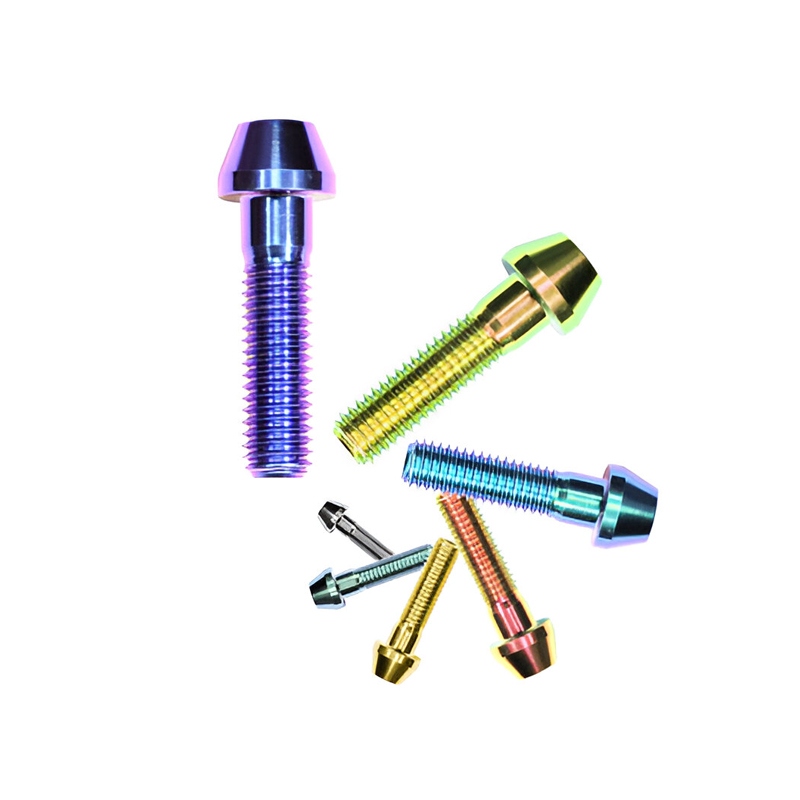Introduction to Titanium Stem Bolts
Titanium stem bolts are high-performance fasteners engineered for applications requiring exceptional strength-to-weight ratios and corrosion resistance. These bolts are manufactured from titanium alloys, primarily Grade 5 (Ti-6Al-4V) or Grade 2 (commercially pure titanium), offering unique mechanical properties that outperform conventional steel fasteners in demanding environments.
Key Characteristics: Titanium stem bolts combine the lightweight nature of titanium (4.43 g/cm³ density, approximately 56% of steel) with tensile strengths ranging from 240 MPa (Grade 2) to 1,034 MPa (Grade 5), while maintaining excellent fatigue resistance (endurance limits of 500-600 MPa at 10⁷ cycles).

Technical Specifications and Performance Data
The exceptional properties of titanium stem bolts are quantified through rigorous testing:
Mechanical Strength: Grade 5 titanium bolts achieve ultimate tensile strength of 1,034 MPa and yield strength of 828 MPa, with a modulus of elasticity of 113.8 GPa
Corrosion Resistance: Demonstrates 0.0005 mm/year corrosion rate in salt spray tests (ASTM B117), outperforming stainless steel by 5-10x in chloride environments
Thermal Performance: Maintains structural integrity from -250°C to 600°C with a thermal expansion coefficient of 8.6 x 10⁻⁶/°C
Fatigue Life: Exhibits 10⁷ cycle endurance limit at 50% of UTS in axial loading conditions
Galvanic Compatibility: Requires isolation with 0.15V maximum potential difference when coupled with dissimilar metals
Specialized Applications
Titanium stem bolts serve critical functions across multiple Industries:
Aerospace Engineering
In aircraft assemblies, titanium bolts provide 40% weight reduction versus steel equivalents while meeting FAA AC 20-107B compliance for airframe fasteners. Used in wingbox attachments, engine mounts, and landing gear components where fatigue life exceeds 100,000 flight cycles.
Marine Technology
Subsea applications utilize titanium's immunity to seawater corrosion, with zero measurable corrosion after 10-year immersion tests per ASTM G31. Critical for ROV systems, desalination plants, and offshore platform components exposed to 3.5% NaCl environments.
Medical Implants
Biocompatible Grade 23 (Ti-6Al-4V ELI) stem bolts meet ISO 5832-3 standards for orthopedic devices, demonstrating osseointegration success rates >95% in dental and spinal fixation systems.
High-Performance Automotive
Formula 1 teams leverage titanium fasteners for suspension systems, achieving 35% mass reduction in unsprung weight while withstanding 5,000 N·m shock loads during impact events.
Maintenance Protocols
Proper care extends service life and maintains performance:
Installation Best Practices: Use torque values 25-30% lower than equivalent steel bolts due to titanium's lower modulus (e.g., M10 Grade 5 bolt requires 75 N·m vs 100 N·m for 8.8 steel). Always employ anti-seize compounds (molybdenum disulfide or nickel-based) to prevent galling.
Cleaning: Use pH-neutral cleaners (5.5-8.5 range) with <30>for blast cleaning. Avoid chlorinated solvents which may induce stress corrosion cracking.
Inspection: Conduct fluorescent penetrant testing (ASTM E1417) every 5,000 service hours to detect sub-surface defects. Measure bolt stretch with 0.001 mm precision micrometers.
Storage: Maintain in <40% rh="" environments="">with vapor corrosion inhibitors (VCIs). Separate from cadmium-plated components (minimum 50 mm spacing).
Replacement Criteria: Discard bolts exhibiting >3% permanent elongation or thread deformation exceeding 10% of pitch diameter per ASME B18.2.1.
Surface Treatment Options
Advanced coatings enhance performance:
Anodizing: Type II anodizing creates 5-25 μm oxide layers with 1,500 Vickers hardness for wear resistance
Plasma Spray: Yttria-stabilized zirconia coatings provide 1,200°C thermal barrier for exhaust systems
Nitriding: Low-temperature plasma nitriding (500°C) increases surface hardness to 1,100 HV
Failure Analysis
Common failure modes and prevention:
Galling: Occurs at >25 MPa contact pressure - mitigated by 10-20 μm MoS₂ coatings
Hydrogen Embrittlement: Risk increases at >150 ppm hydrogen content - prevented by vacuum annealing at 700°C
Stress Corrosion: Threshold at 20% of yield strength in chloride environments - addressed by beta annealing treatments





 English
English

